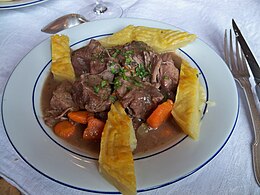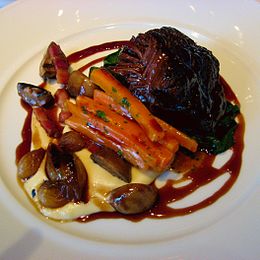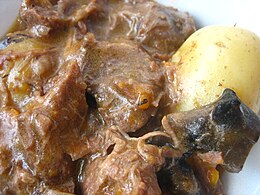food.wikisort.org - Dish
Daube is a classic Provençal (or more broadly, French[1]) stew made with inexpensive beef braised[2] in wine, vegetables, garlic, and herbes de Provence, and traditionally cooked in a daubière,[1] a braising pan.[3] A traditional daubière is a terracotta pot that resembles a pitcher, with a concave lid. Water is poured on the lid, which condenses the moisture inside, allowing for the long cooking required to tenderize lesser cuts of meat. The meat used in daube is cut from the shoulder and back of the bull,[citation needed] though some suggest they should be made from three cuts of meat: the "gelatinous shin for body, short ribs for flavor, and chuck for firmness."[1] Although most modern recipes call for red wine,[3] a minority call for white,[4] as do the earliest recorded daube recipes.[citation needed]
This article needs additional citations for verification. (June 2011) |
 | |
| Type | Stew |
|---|---|
| Place of origin | France |
| Region or state | Provence |
| Main ingredients | Beef, wine, vegetables, garlic, herbes de Provence |
Daube is adapted in New Orleans cuisine to make daube glacé.
Variations also call for olives, prunes, and flavoring with duck fat, vinegar, brandy, lavender, nutmeg, cinnamon, cloves, juniper berries, or orange peel.[5][citation needed] For best flavor, it is cooked in several stages, and cooled for a day after each stage to allow the flavors to meld together. In the Camargue and Béarn area of France, bulls killed in bullfighting festivals are often used for daube.[citation needed]
Traditionally it should be cooked for a long time and prepared the night before it is served.[1][3] Daube with lamb is traditionally made with white wine.[citation needed]
Daubière
A daube is traditionally made in a daubière, a potbellied earthenware pot with a small base and small opening with a canalled lid that water is poured into.[6] The pot is filled and placed into coals or onto the stove, the lid canal is filled with water, and the contents are slowly cooked.[6] As little liquid as possible is used, and the clay pot prevents the contents from drying.[6] The connective tissues in the meats are gelatinized rather than dissolved.[6] The water in the lid keeps the top of the pot at no more than boiling hot, preventing overcooking of the contents.[6] The temperature of the top of the pot is cooler than that of the bottom, which creates a cycling of vapors and a syrupy result.[6]
Dishes related to the daube described above are the daube gardiane from the Camargue (with bull meat), the estouffade de boeuf, also called stufatu, from Corsica (in which maccheroni are also stewed at the end of the cooking time), but also dishes called daube from other, regions further north (e.g. the daube charentaise, in the preparation of which the whole piece of meat is stewed in white wine).[7]
What all methods of preparation have in common is that the braising liquid is hardly reduced at the end of the cooking time and is never bound with starch (flour, cornflour, etc.), which is often the case in northern braised dishes (boeuf bourguignon, carbonnade flamande, etc.). In the past it was also common to bind the braising liquid of a stave prepared with venison with freshly slaughtered hare or rabbit blood, i. H. At the end of the cooking time, stir the blood into the braising liquid with a few tablespoons of vinegar and let it boil carefully until a creamy sauce is formed.[8]

A daube is best made in a daubière. The shapes of the pot makes sure condensation builds and no evaporation occurs, so everything stays moist.
- Examples of daube of beef
- Daube of beef with lardons, carrots, and button mushrooms, served on parsnip puree
- Daube de boeuf with buttered carrots and peas at Bistro Jeanty in Yountville, California
See also
- Pot-au-feu
- List of stews
References
- David Leite (November 30, 2009). "Paula Wolfert's Beef Daube is as Authentic as It Gets". Leite's Culinaria. Retrieved 2011-06-20.
- "Daube". Merriam-Webster. Retrieved 2011-06-20.
- "Daube of beef". Boston.com. January 26, 2011. Archived from the original on April 6, 2012. Retrieved 2011-06-20.
- Montayne, P. New Larousse Gastronomique, Hamlyn London 1977, p106
- New Larousse Gastronomique, op. cit.
- Wolfert, Paula (2009). Mediterranean clay pot cooking : traditional and modern recipes to savor and share. Hoboken, N.J.: John Wiley & Sons. p. 149. ISBN 978-0-7645-7633-1. OCLC 298538015.
- Vergl. Robert J. Courtine, München 1982, S. 153 u. 164.
- Vergl. Robert J. Courtine, München 1982, S. 410.
External links
| Wikimedia Commons has media related to Daube provençale. |
| Look up daube in Wiktionary, the free dictionary. |
- "Daube de Boeuf". Saveur (#8). Archived from the original on 2008-03-29. Retrieved 2011-06-20.
- "Braising Makes a Tough Cut Tender". Science of Cooking. Exploratorium. Retrieved 2011-06-20.
Think carbonnade, pot roast, fricassee, stew, or daube. While all these dishes are variations on braising, most are more complex than those enjoyed by our ancestors.
На других языках
- [en] Daube
[ru] Доб (блюдо)
Доб (фр. Daube) — это классическое прованское (или, в более широком смысле, французское[1]) рагу, приготовленное из недорогой говядины, баранины[2], тушенной в вине, овощах, чесноке и прованских травах и традиционно приготовленное в добьере[1], специальном горшочке для тушения[3]. Традиционный daubière представляет собой терракотовый горшок, который напоминает кувшин, с вогнутой крышкой. На крышку наливается вода, которая конденсирует влагу внутри, обеспечивая длительное приготовление, необходимое для размягчения небольших кусков мяса. Мясо, используемое в добе, вырезается из плеча и спины быка, хотя некоторые предполагают, что блюдо должно быть сделано из трёх кусков мяса: «студенистая голень для тела, рёбра для вкуса и вырезка для твердости»[1]. Хотя большинство современных рецептов требуют красного вина[3], меньшее количество требует белого[4], как и самые ранние записанные рецепты доба. Доб с бараниной традиционно готовят с добавлением белого вина.Другой контент может иметь иную лицензию. Перед использованием материалов сайта WikiSort.org внимательно изучите правила лицензирования конкретных элементов наполнения сайта.
WikiSort.org - проект по пересортировке и дополнению контента Википедии


